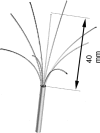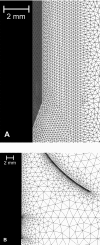Effects of variation in perfusion rates and of perfusion models in computational models of radio frequency tumor ablation
- PMID: 18777906
- PMCID: PMC2673648
- DOI: 10.1118/1.2948388
Effects of variation in perfusion rates and of perfusion models in computational models of radio frequency tumor ablation
Abstract
Purpose: Finite element method (FEM) models are commonly used to simulate radio frequency (RF) tumor ablation. Prior FEM models of RF ablation have either ignored the temperature dependent effect of microvascular perfusion, or implemented the effect using simplified algorithms to reduce computational complexity. In this FEM modeling study, the authors compared the effect of different microvascular perfusion algorithms on ablation zone dimensions with two commercial RF electrodes in hepatic tissue. They also examine the effect of tissue type and inter-patient variation of perfusion on ablation zone dimensions.
Methods and materials: The authors created FEM models of an internally cooled and multi-tined expandable electrode. RF voltage was applied to both electrodes (for 12 or 15 min, respectively) such that the maximum temperature in the model was 105 degrees C. Temperature dependent microvascular perfusion was implemented using three previously reported methodologies: cessation above 60 degrees C, a standard first-order Arrhenius model with decreasing perfusion with increasing degree of vascular stasis, and an Arrhenius model that included the effects of increasing perfusion at the ablation zone boundary due to hyperemia. To examine the effects of interpatient variation, simulations were performed with base line and +/-1 standard deviation values of perfusion. The base line perfusion was also varied to simulate the difference between normal and cirrhotic liver tissue.
Results: The ablation zone volumes with the cessation above 60 degrees C perfusion algorithm and with the more complex Arrhenius model were up to 70% and 25% smaller, respectively, compared to the standard Arrhenius model. Ablation zone volumes were up to 175% and approximately 100% different between the simulations where -1 and +1 standard deviation values of perfusion were used in normal and cirrhotic liver tissue, respectively.
Conclusions: The choice of microvascular perfusion algorithm has significant effects on final ablation zone dimensions in FEM models of RF ablation. The authors also found that both interpatient variation in base line tissue perfusion and the reduction in perfusion due to cirrhosis have considerable effect on ablation zone dimensions.
Figures









References
-
- McTaggart R. A. and Dupuy D. E., “Thermal ablation of lung tumors,” J. Vasc. Interv. Radiol. 10, 102–113 (2007). - PubMed
-
- Schiller J. D., Gervais D. A., and Mueller P. R., “Radio frequency ablation of renal cell carcinoma,” Abdom. Imaging 30, 442–450 (2005). - PubMed
-
- Solbiati L., “Percutaneous ultrasound-guided radio frequency ablation of HCC and liver metastases: Results and long-term 7-year follow-up,” Ultrasound Med. Biol. 29, S48 (2003).
-
- Lobo S. M., Liu Z., Yu N. C., Humphries S., Ahmed M., Cosman E. R., Lenkinski R. E., Goldberg W., and Goldberg S. N., “RF tumour ablation: Computer simulation and mathematical modelling of the effects of electrical and thermal conductivity,” Int. J. Hyperthermia 21, 199–213 (2005). - PubMed
Publication types
MeSH terms
Grants and funding
LinkOut - more resources
Full Text Sources

